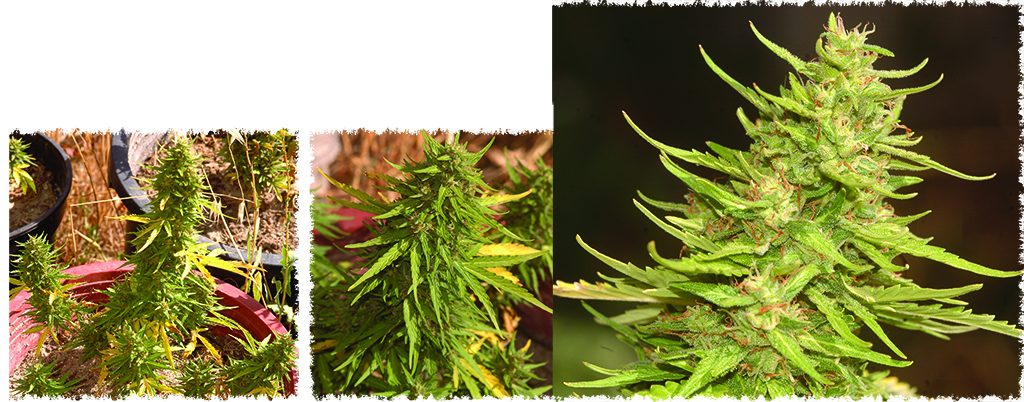Fifty five days and a great harvest...
The White Dwarf is an autoflowering strain that is gaining a place on the podium of the giant dwarfs. Perhaps the most remarkable feature of this variety is the genetic strength, this strength makes her thrive in hostile conditions, therefore it’s an ideal plant for guerrilla growing since its water requirements are quite low. If you don’t have a good garden, this is the perfect plant to choose, as you know that everything will be fine come harvest time.
Drought, poor substrate, unbearable heat, rodents, pests and everything you can imagine were the travelling companions of these plants. Nobody would have bet one dollar on their survival. But sometimes genetics can become miracles and certainly this is a case of extreme survival.
A person, who had never grown marijuana, and has not had the slightest interest in it, received five seeds of the White Dwarf variety. It was a gift; he did not value or know about them. He knew it was cannabis but he had never before cultivated. As he was not sure about his results he chose to do something between normal growth and guerrilla. In other words, we would leave his plants a little neglected.
He put the five seeds in water for 24 hours. The water was taken from the nearest river; this would be the same sort of water that would irrigate the plants if they prospered in such a hostile environment they would have to grow. The five seeds sank into the water glass within 24 hours, which meant they were viable, at least in theory. Then he filled five pots with the same soil found near the river. He put in the seeds an inch deep.
The soil next to the river had some silt, which whilst being enriched… would it be enough? The silt from river floods contains organic matter that serves as fertilizer. However, to get the best marijuana more than that is needed.
Moreover, burying the seeds an inch deep in hot weather has many drawbacks. If you do it in spring is perfect. But at the height of summer you run the risk that the substrate overheats too much and destroys the emerging seedlings that are still very delicate. In fact, the gardener planted other varieties and all perished except one, an Afghan Kush.
Only these White Dwarfs and the aforementioned thrived with great joy. To make matters worse, the plants were placed in the middle of their natural environment, full of weeds, pests etc. Only a small metal fence served as anti-rodent armor.
The fact that the plants were completely surrounded by the vegetation of the area, mostly wild oats, made temperatures rise significantly due to lack of air circulation. However, these dwarfs behaved as giants and they did not seem to suffer at all, on the contrary. For this reason I think they are particularly suitable for guerrilla growing in midsummer, when nobody has good marijuana.
The pictures we show you speak for themselves about the vicissitudes the girls passed. They germinated on June 10 and were harvested on August 1st. Not bad as in just 50 days we obtain a considerable amount of fresh and outdoor weed. “Next year I will cultivate much more …” – says its owner, happy to see he has good marijuana in midsummer, when no one has anything.
Something particularly positive the gardener did was to add microorganisms to the substrate. Millions and billions of microbes, fungi and bacteria that took care of turning all the silt brought by the river floods into available food for the fine roots of the plants. This is a very positive practice for any crop, even more when it comes to guerrilla growing since the chances to fertilize are greatly reduced for obvious reasons. Normally, the “guerrilla” gardener cannot go to fertilize or water daily. Plants are located far away; he will have to walk a long way and even sometimes crawl to reach them. Therefore, if we can’t fertilize the ideal thing is to provide plants with millions and millions of beneficial bacteria that will do the job for you.
Our gardener followed an old recipe. He put microorganisms in a bucket of water and added a little brown sugar; removed all the material and let it stand for three days. After this time, the microorganisms had reproduced and reached their limits of space.
This 10-liter bucket was enough to refill ten buckets more with the same mixture. Indeed, the original bucket was left in the shade and protected from light (sunlight contains antibacterial UV rays). Every time he watered he collected river water and mixed it with the water full of the microorganisms.
We have seen one of the reasons why he did this. There are more, it was definitely a very smart idea. Let’s see why. The river, which supplied the gardener of our report, was a very small one. The amount of water running through it was low but very thick and the EC soared to tremendous levels. But, what was causing such a high electrical conductivity? It was precisely all the organic and mineral matter contained. Microorganisms feed on this organic and mineral matter.
The river was rich in minerals, silt etc. therefore, the fact of putting microorganisms in the soil means helping the plants to digest thick water with a very high EC level.
However, it was decided to fertilize some more when flowering started. He chose guano powder and neem cake. The Neem, also in powder, is not food but a great prevention of plagues and other pests. By contrast, the guano is one of the best foods that can be given to cannabis. During the first 15 days he didn’t use any fertilizer except water enriched with the microorganisms. From the 15th day he put in each of the five pots a heaped tablespoon of this great product and then watered sparingly.
It would have been perfect if guano had been mixed with soil before but it wasn’t like that. A heaped tablespoon for each pot of 15 liters was enough for plants not to have major shortcomings. Plants kept on growing until they gave great marijuana.
Its 100% organic content of N, P, K, humic and fulvic acids and ancient leonardite makes it perhaps the most complete mineral and organic fertilizer for growing cannabis.
The second time he fertilized was 15 days after, when there were clear signs of promising and abundant flowering. Again, about 2 grams (one tablespoon) per pot were decisive. The White Dwarfs appreciated it. They had a very strong smell, to the point of being a problem because the aroma was certainly a tell-tale sign of the plants existence.
The White Dwarfs have a fruity essence with a strong musk that is very nice. The fragrance was remarkable with only five plants, especially at night, when smells travel further. It is advisable to put them in places surrounded by other scented plants like honeysuckles that bloom all summer and camouflage suspicious odors.
The third and last fertilizing was the final touch to get the fantastic buds of these white dwarfs. A pot of organic fertilizer for the flowering stage was used, It had a 3-5-6 NPK, which made it ideal for this purpose. Being totally organic, it was great with the combination of microorganisms. Bacteria gobbled up it quickly as it was liquid. Once again the plants re-flowered. They seemed to applaud the gardener.
To sum up, with only three organic and mineral fertilizations and the smart application of efficient microorganisms, more than good, extraordinary plants were achieved… in the middle of summer!
It was worth it.
However, it should be noted that at the end of their lives primary leaves of plants turned yellow. They were missing some nitrogen taken up by the leaves. This is not bad but desirable because the buds are better formed this way, more resinous and compact.
When there were ten days left to harvest, the gardener subjected the plants to drought through the absence of irrigation. Plants began to “sweat” resin thereby increasing their production. Just two days before harvest, which took place the day after the full moon, they were watered again. The buds, softened because of water stress, recovered their formidable appearance. There are supporters and opponents of this type of cultivation. It works very well so long as it’s not carried to extremes.
The biological reason behind this practice is the fact that female plants, whose lives are finishing without having accomplished reproduction, sweat resin in order to be pollinated and fertilized.
A little bit of thirst is fine but not too much. They’re watered at the end, thus buds will be particularly strong and tight.
These plants we show you have been harvested on the 2nd of August. That is, a day after the full moon. Why? During the waxing phase of the moon, the sap rises throughout the xylem of the plant to the top, producing growth and size. Then it goes down the phloem to all parts where it’s needed. The cycle repeats itself, but if we keep in mind the moon phases we’ll get better results.
I can only take my hat off to this plant whose strength is absolutely impressive. This cultivation, between guerrilla and conventional growing, has been an experiment to explore the potential of White Dwarf as guerrilla or simply as a variety of extreme hardness and little difficulty. The White Dwarfs were almost not watered, neither fertilized and no pests affected them. Besides, they got great buds, on the 2nd August!
Definitely, you cannot ask more from a seed.
Originally Published in Weed World Magazine Issue 103








